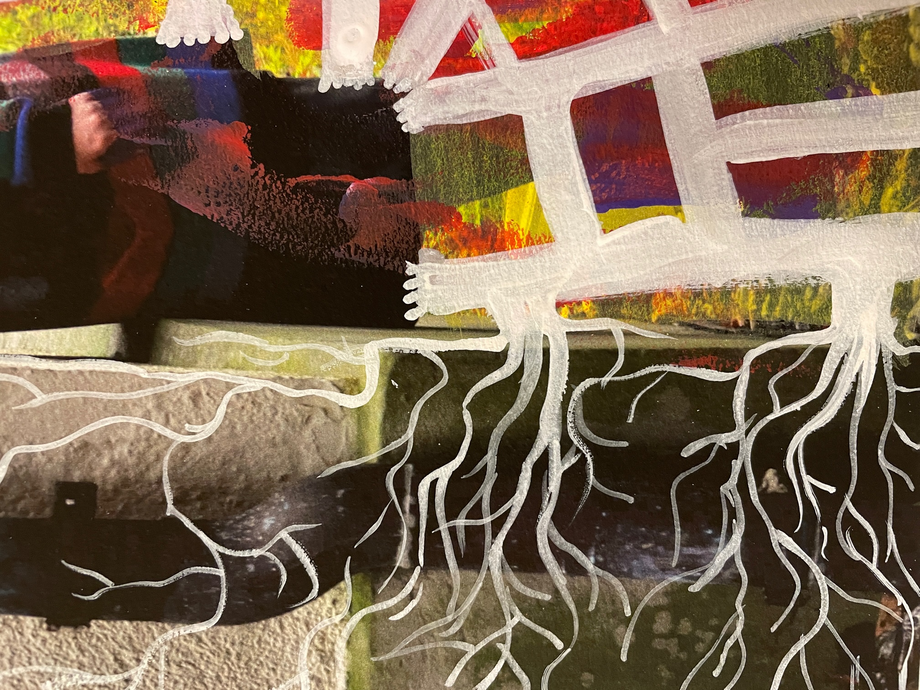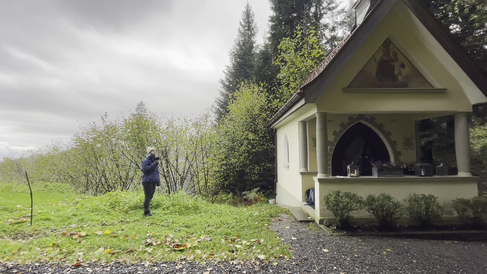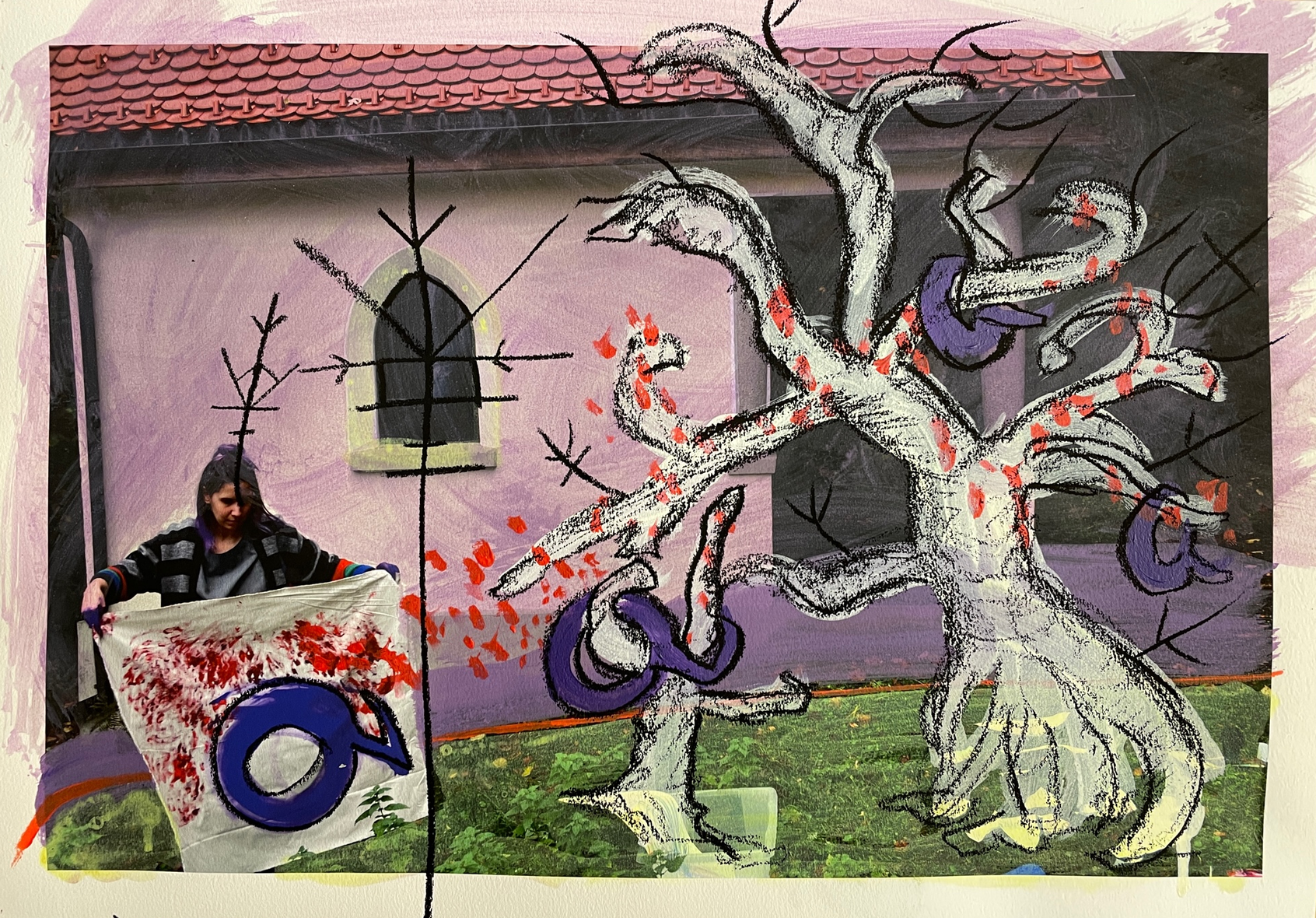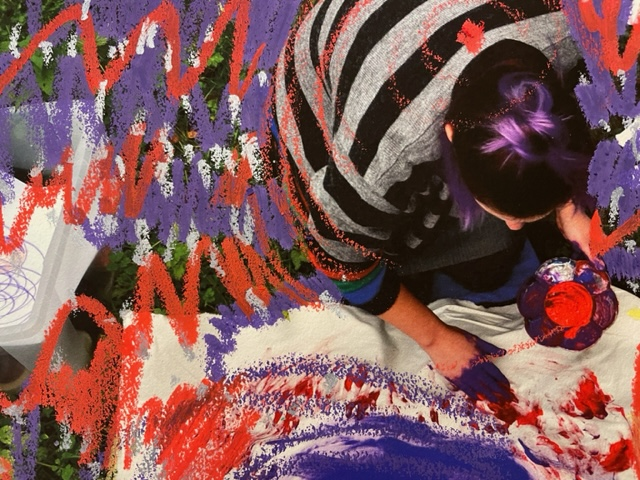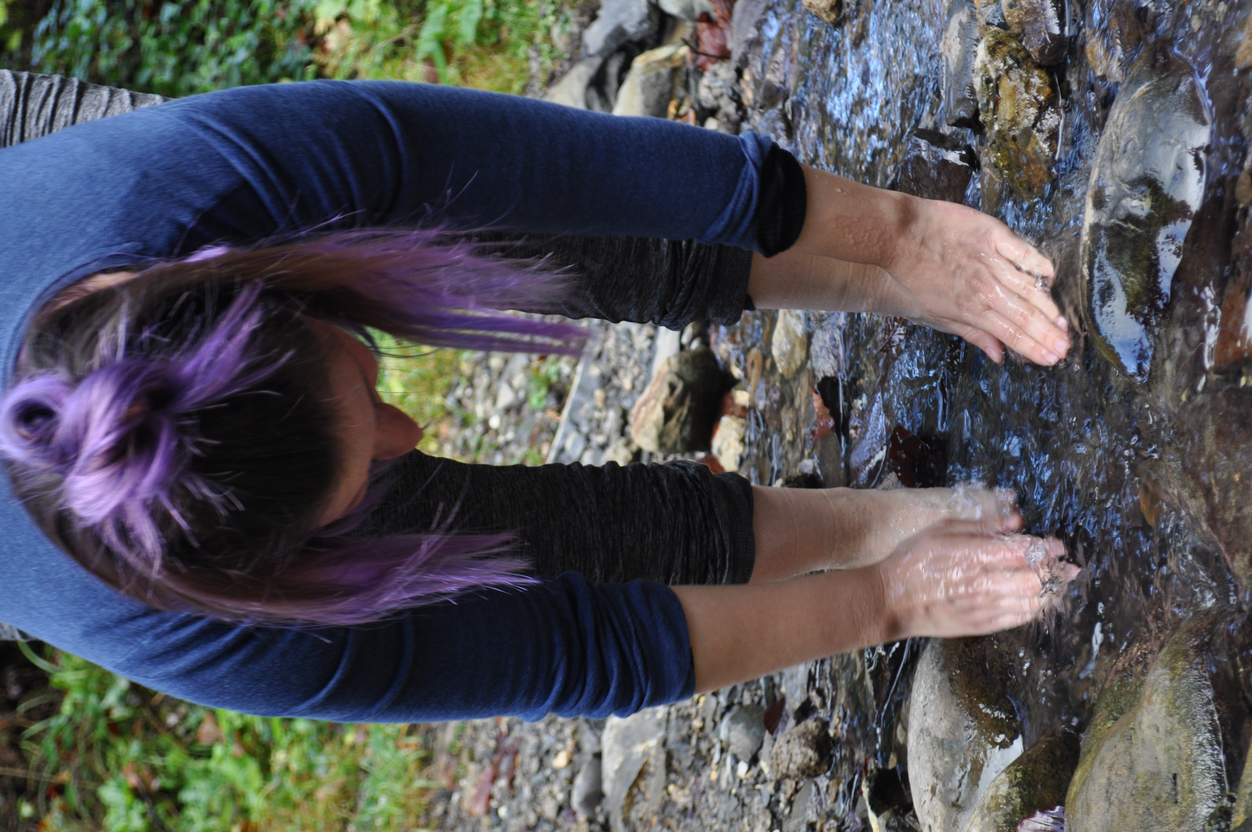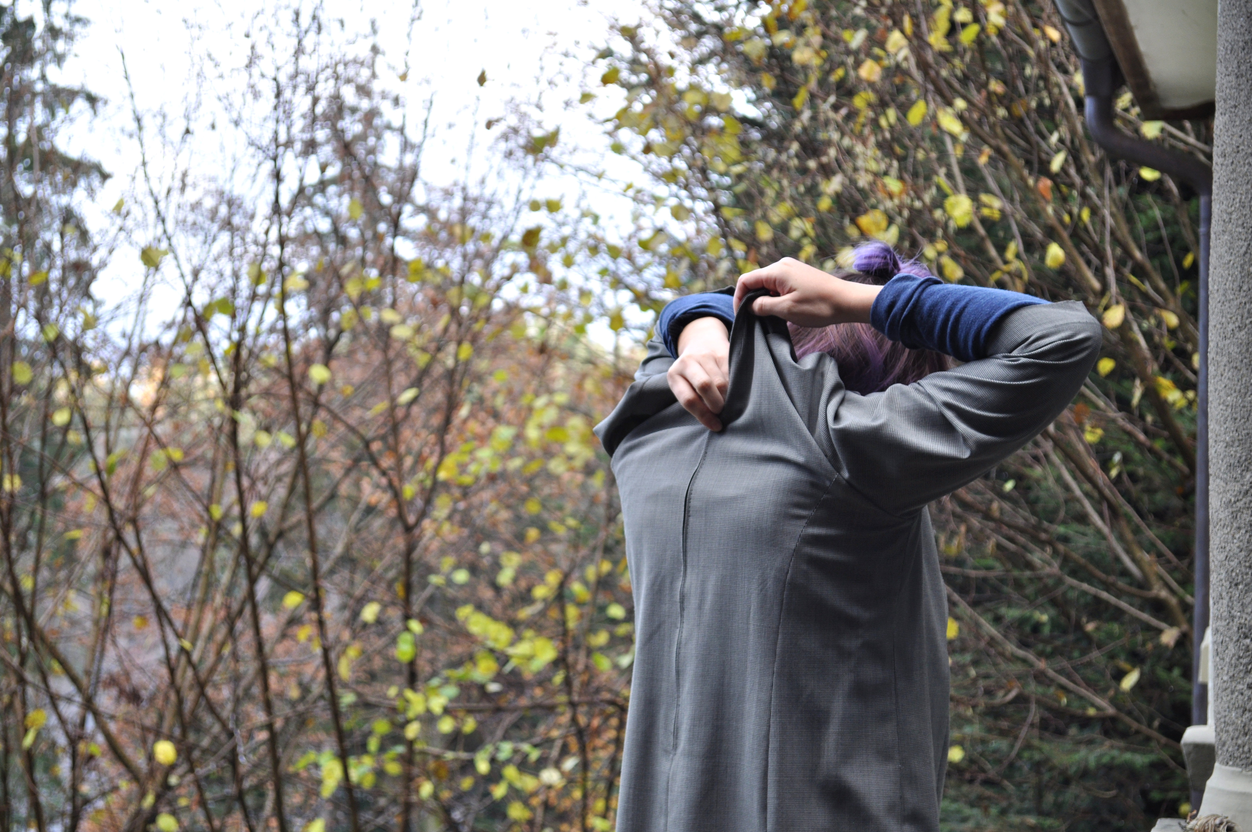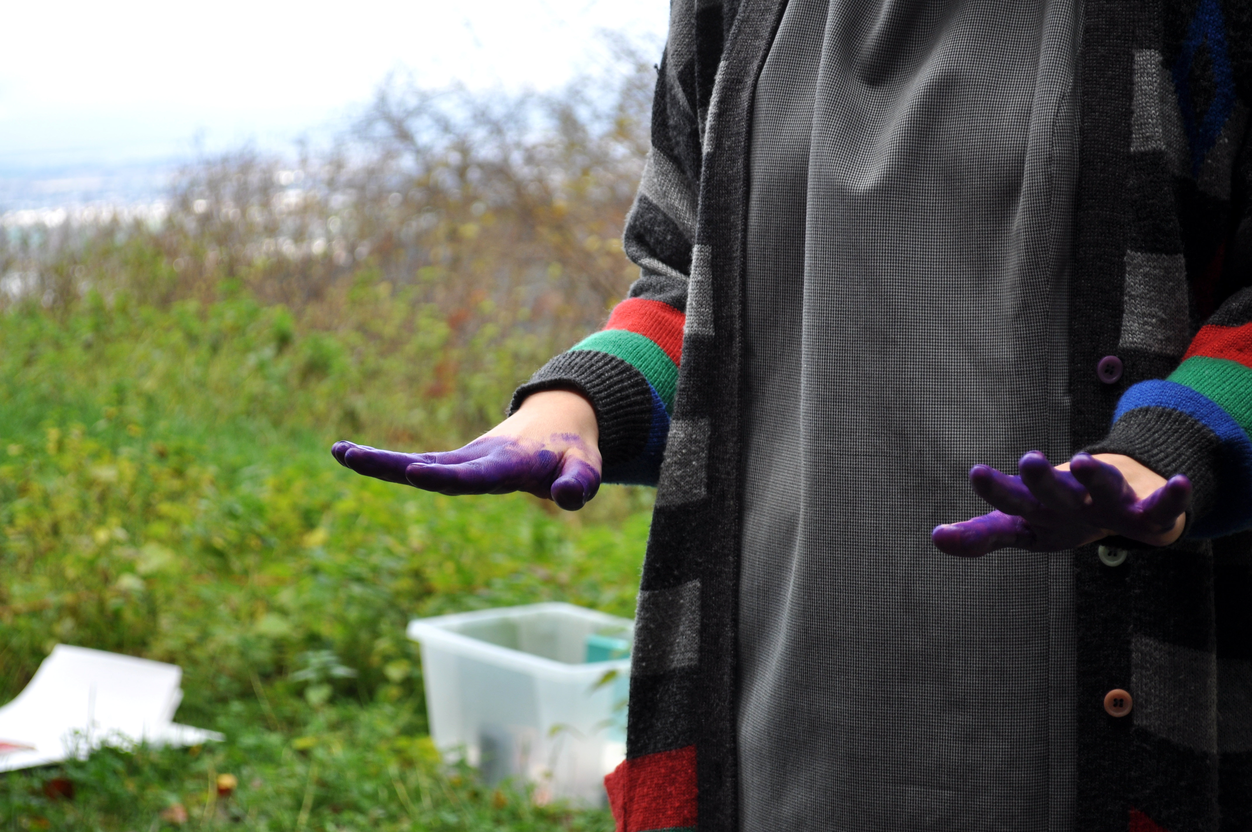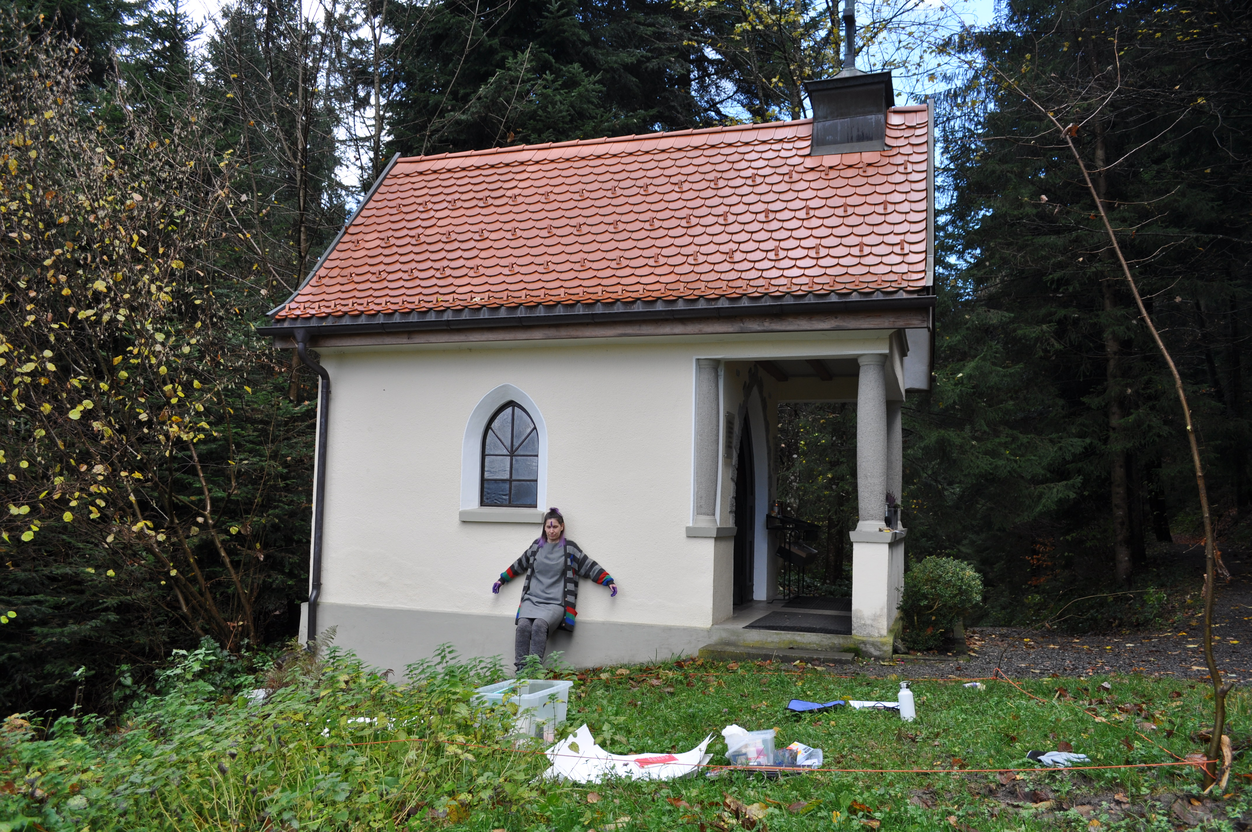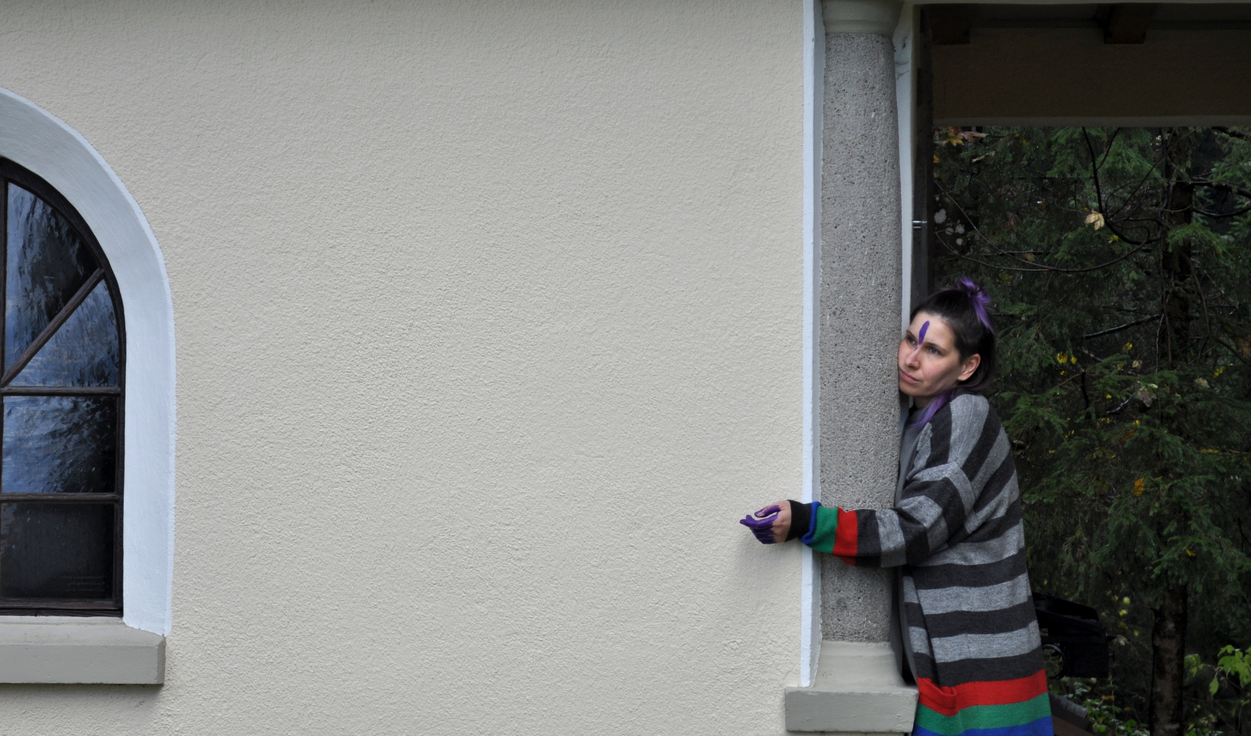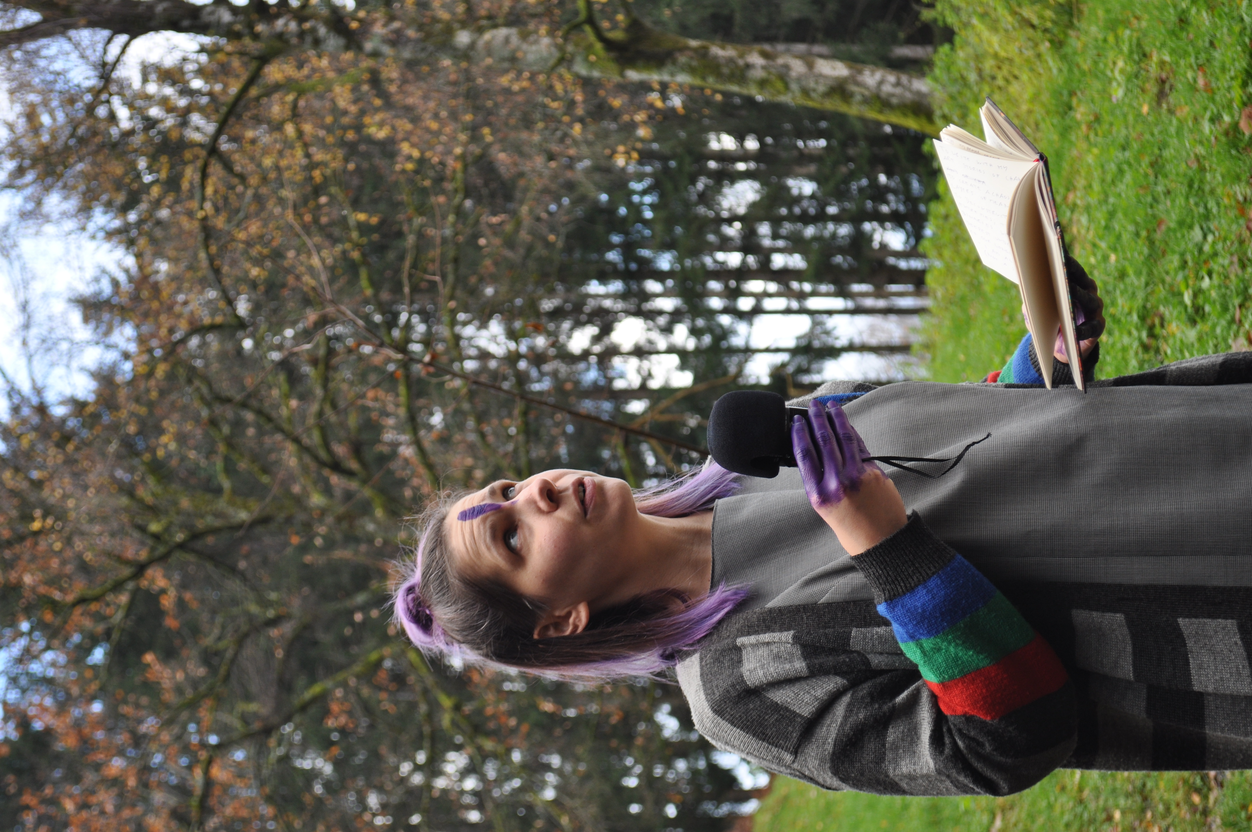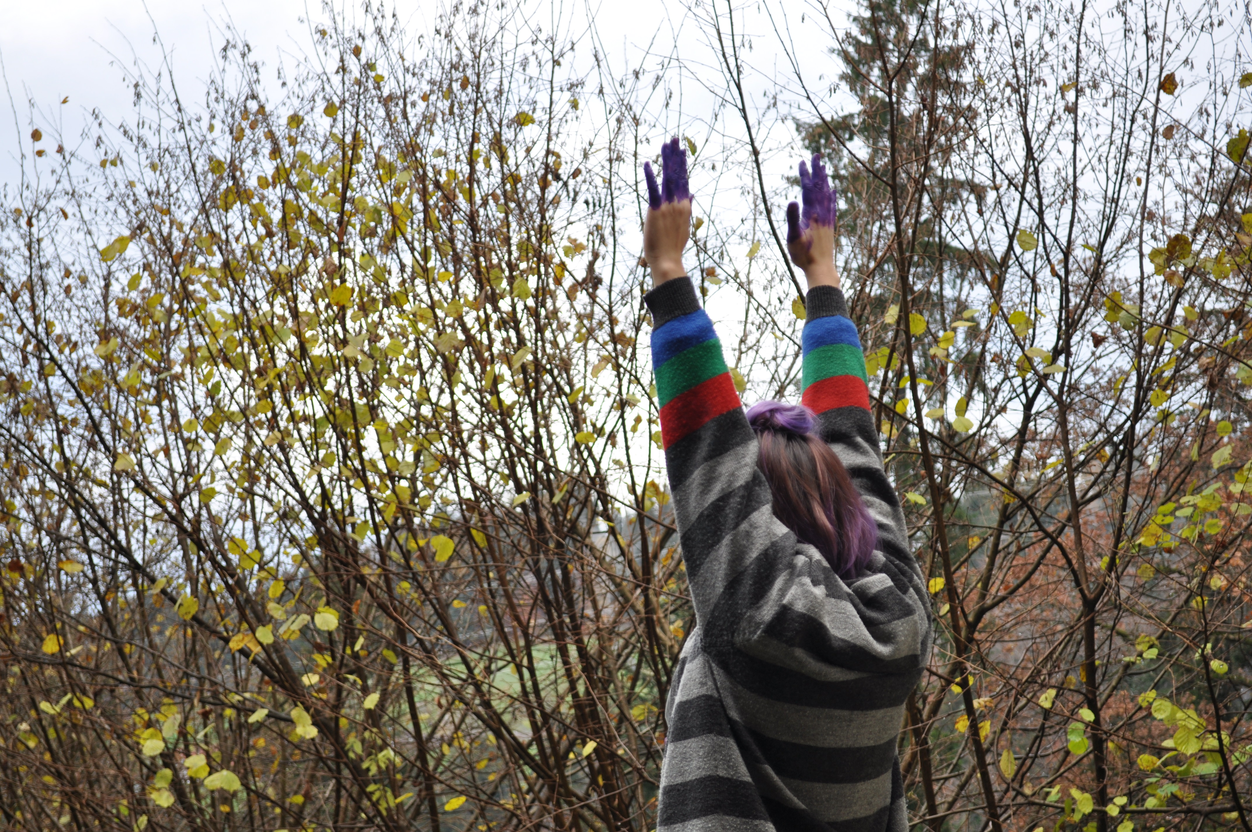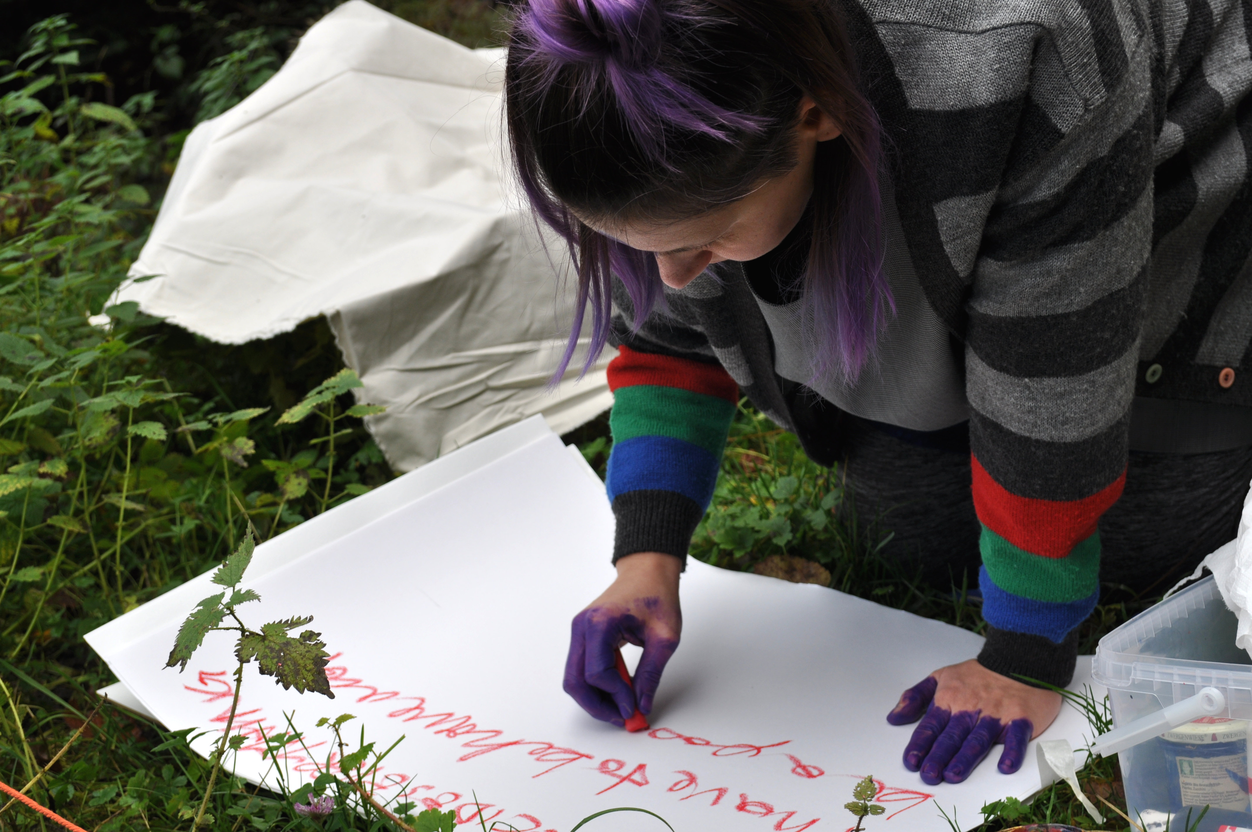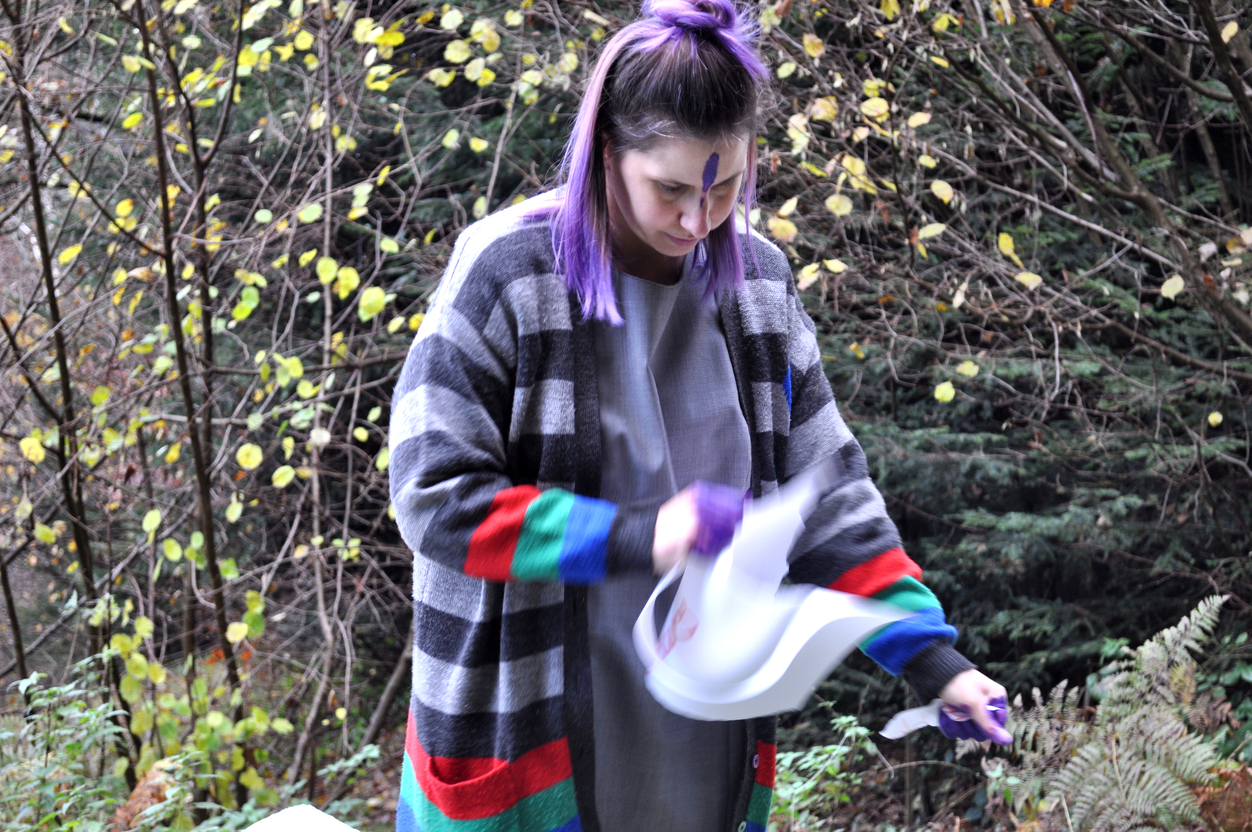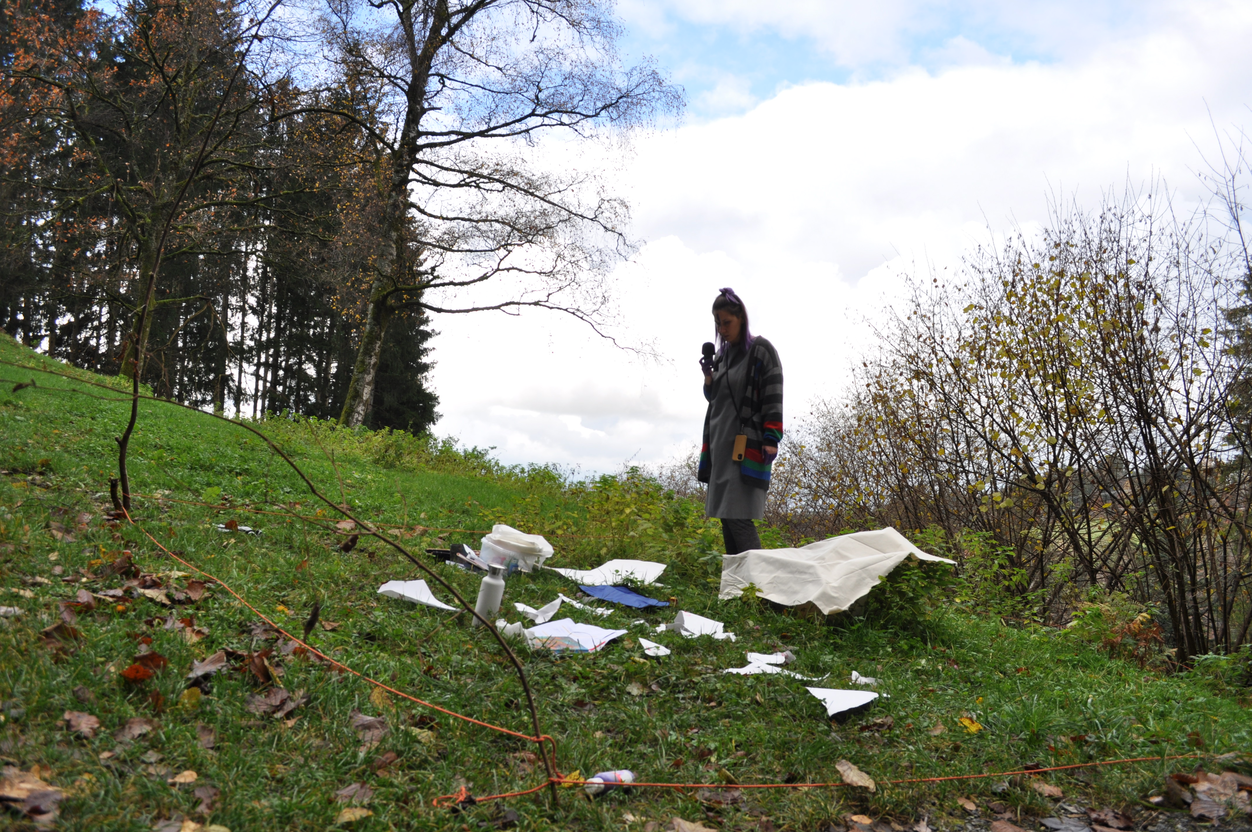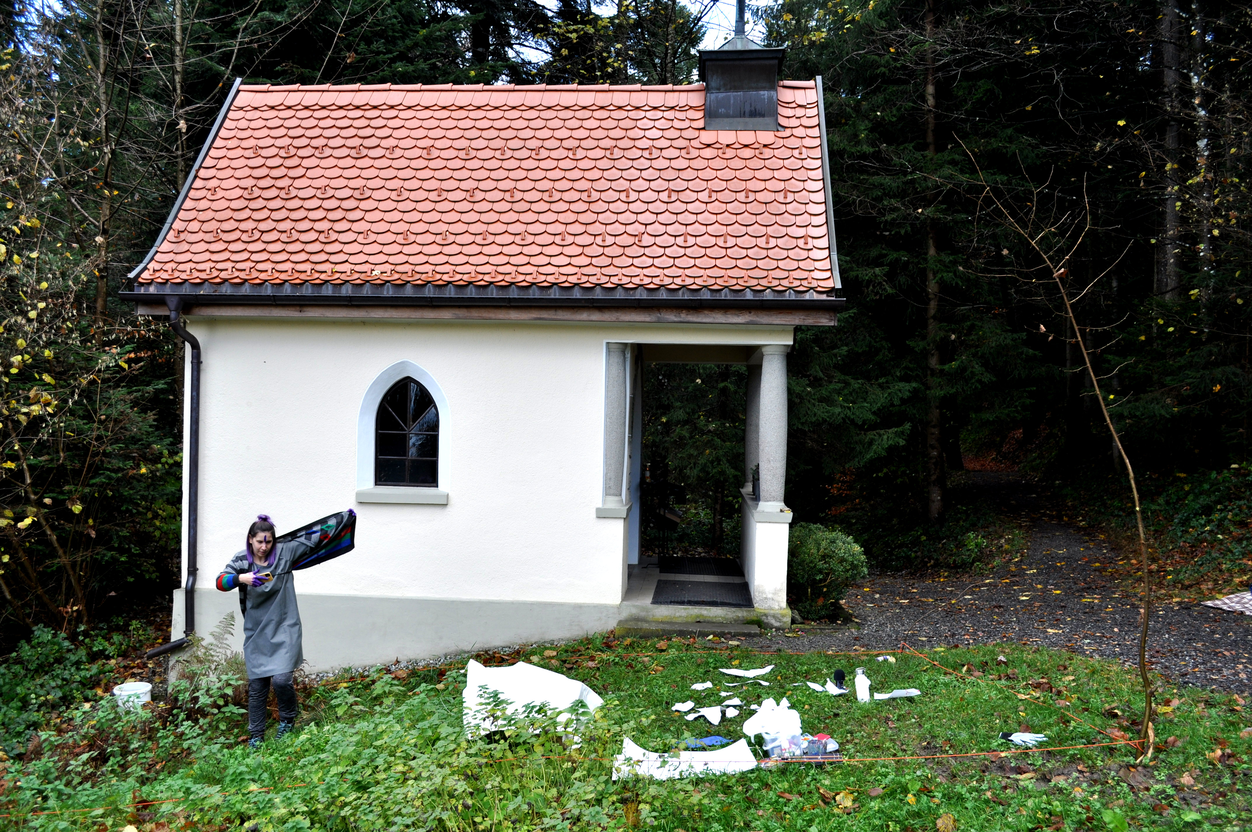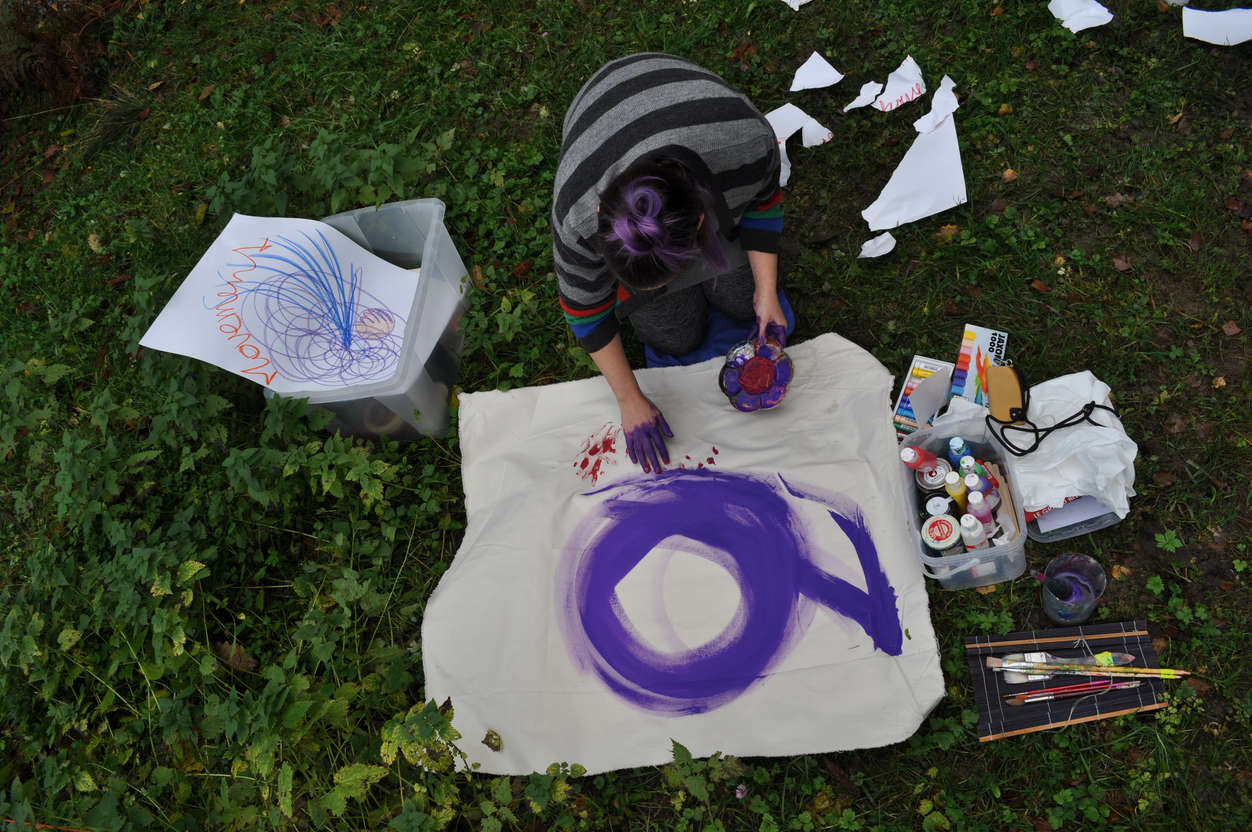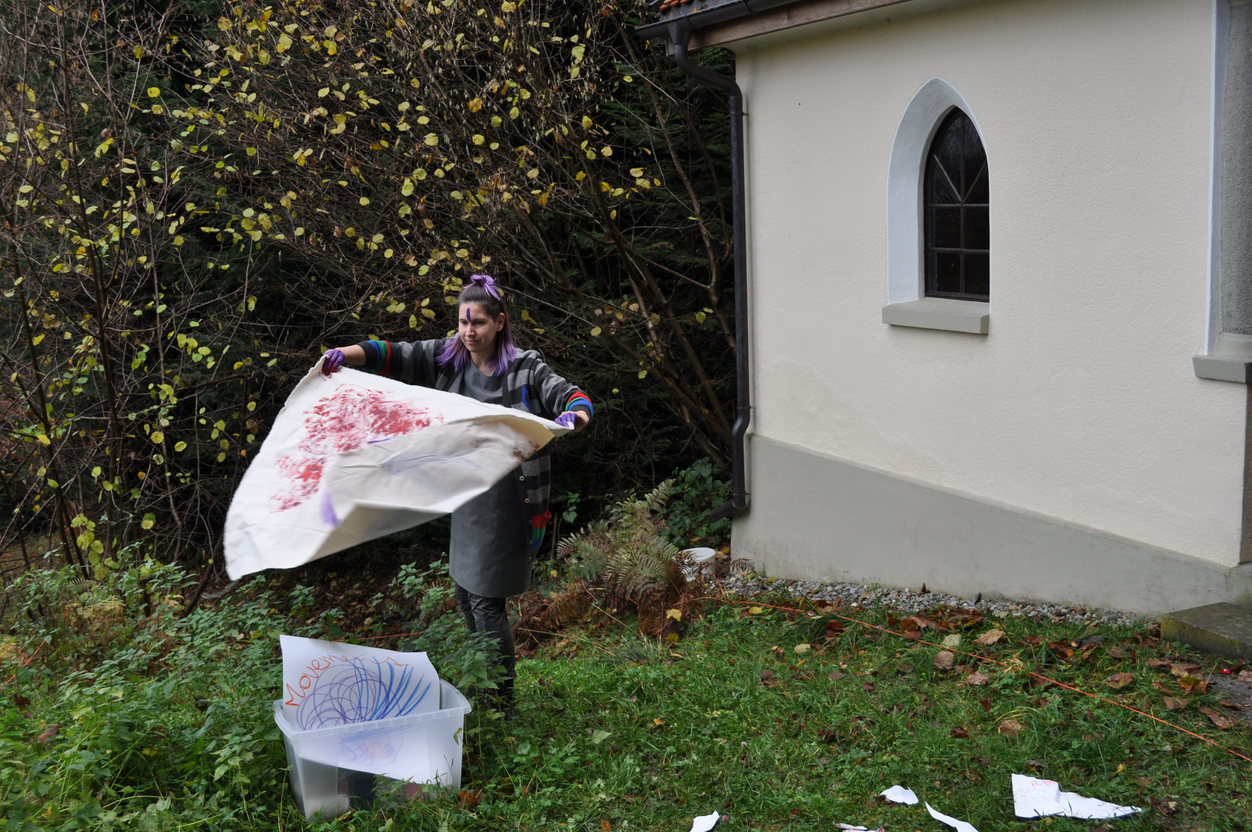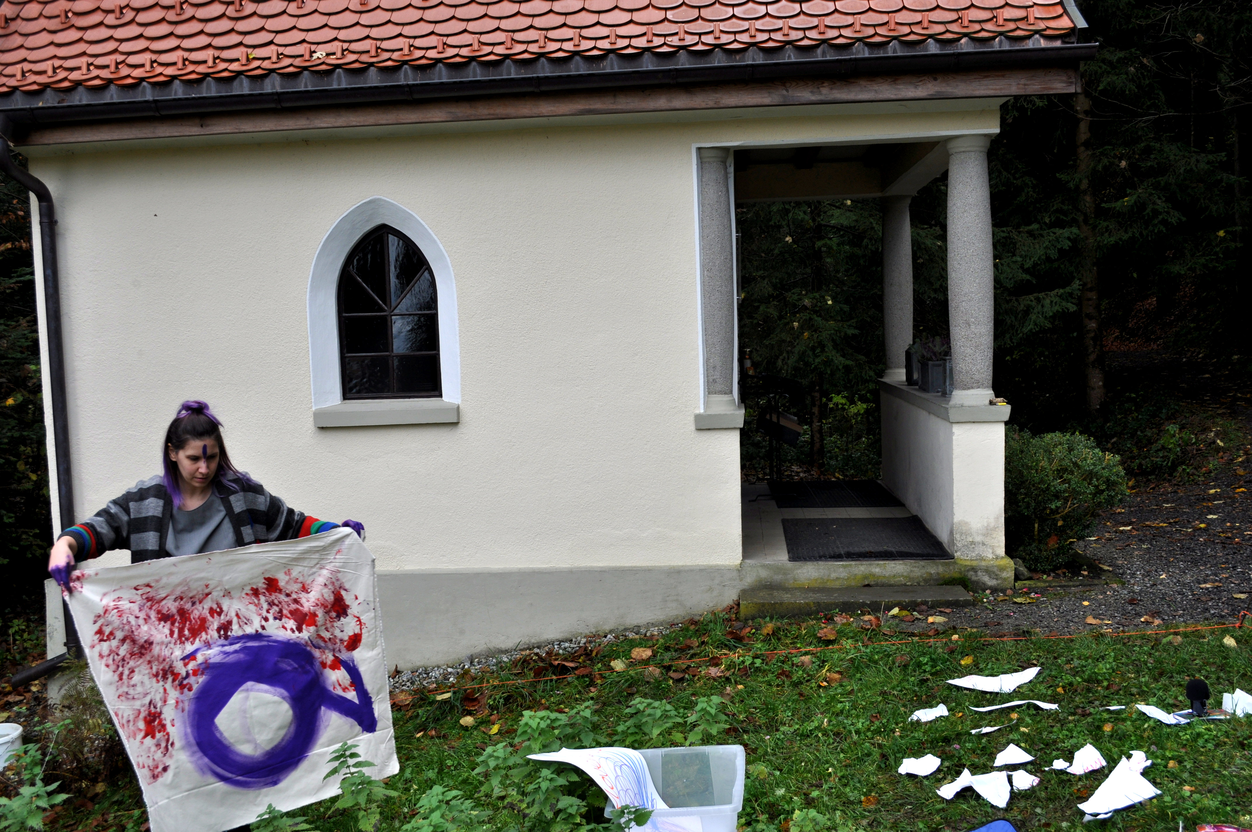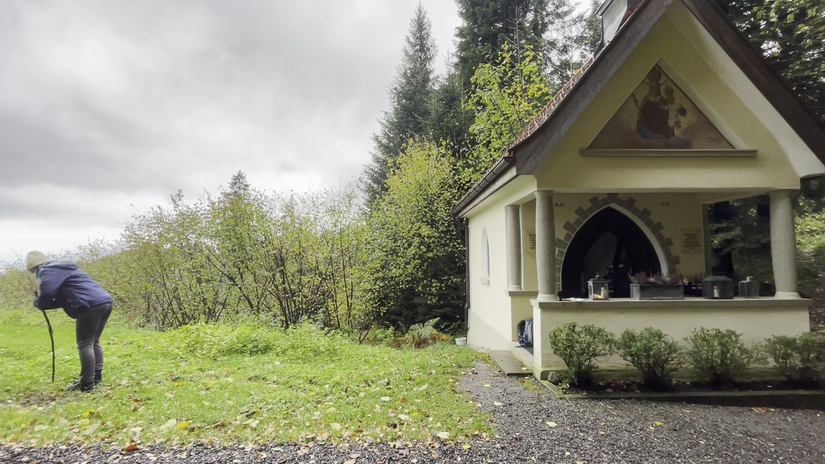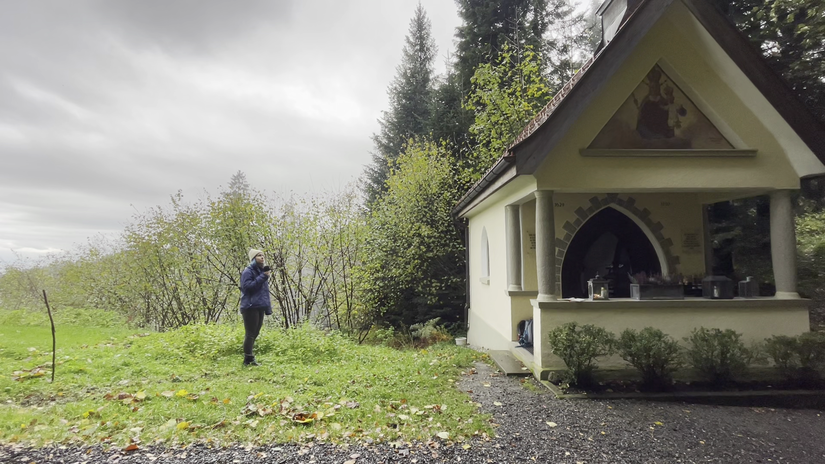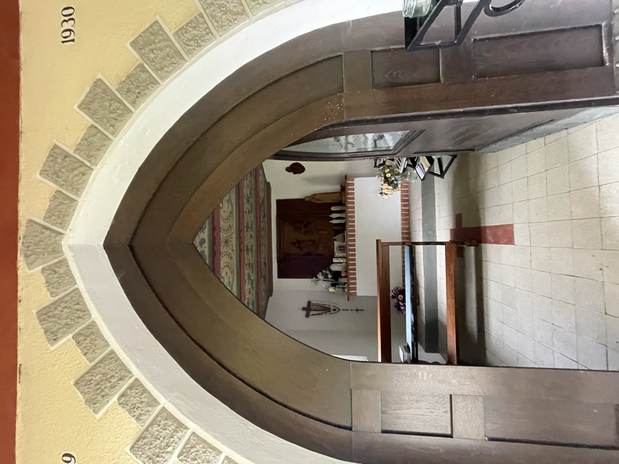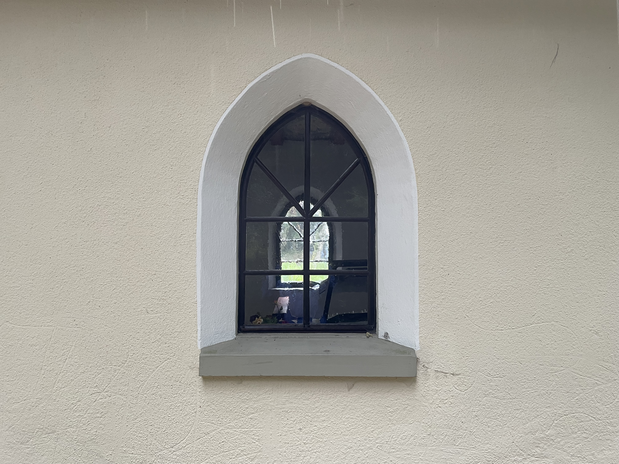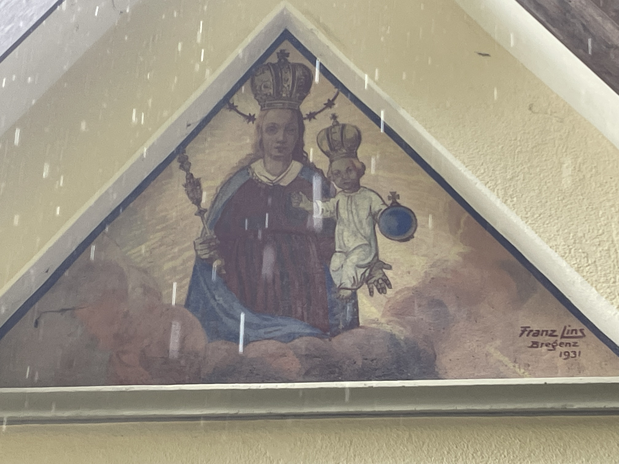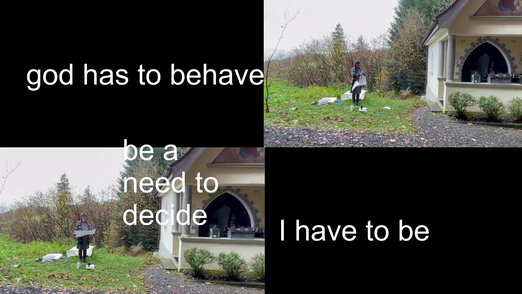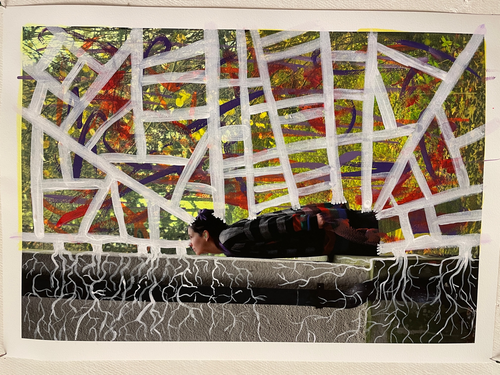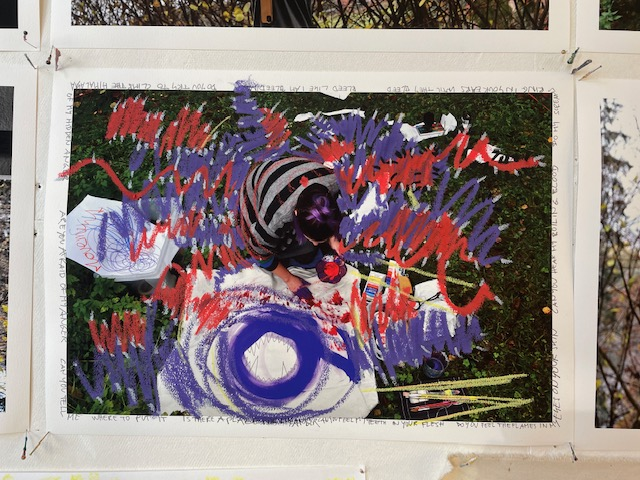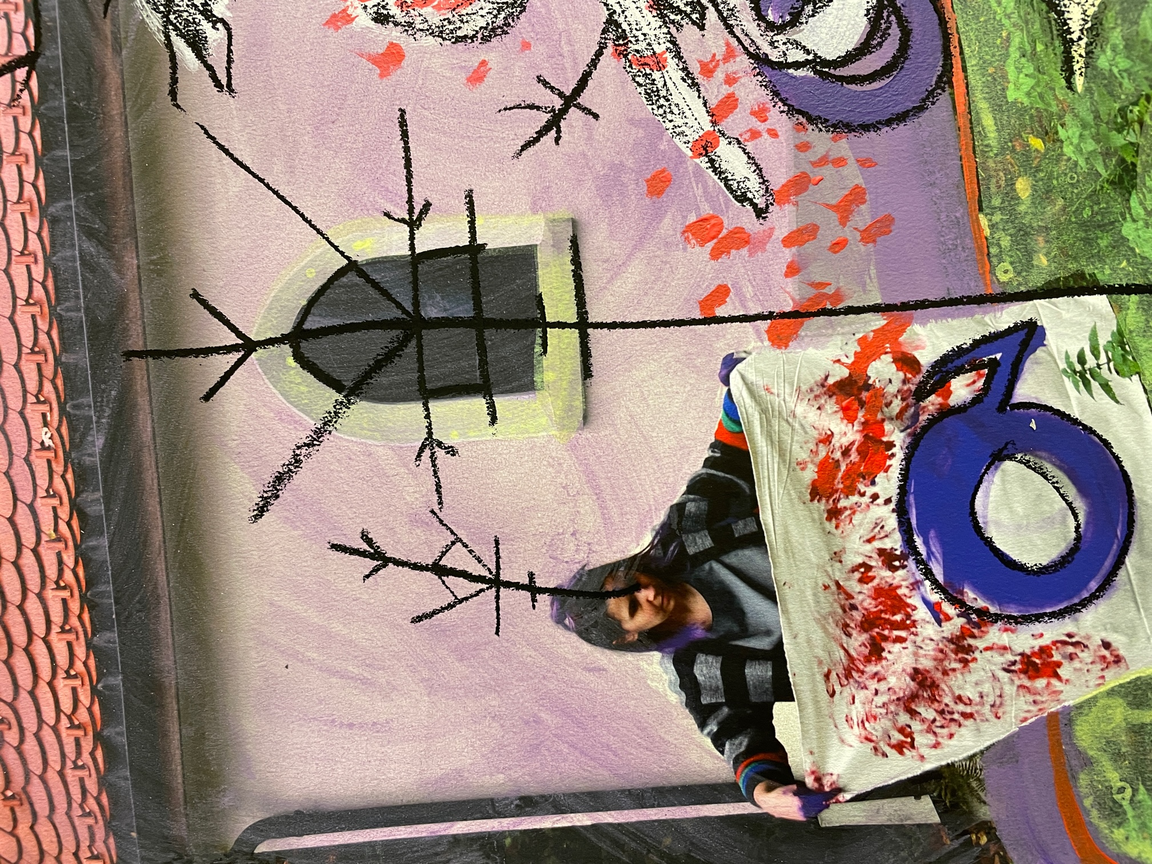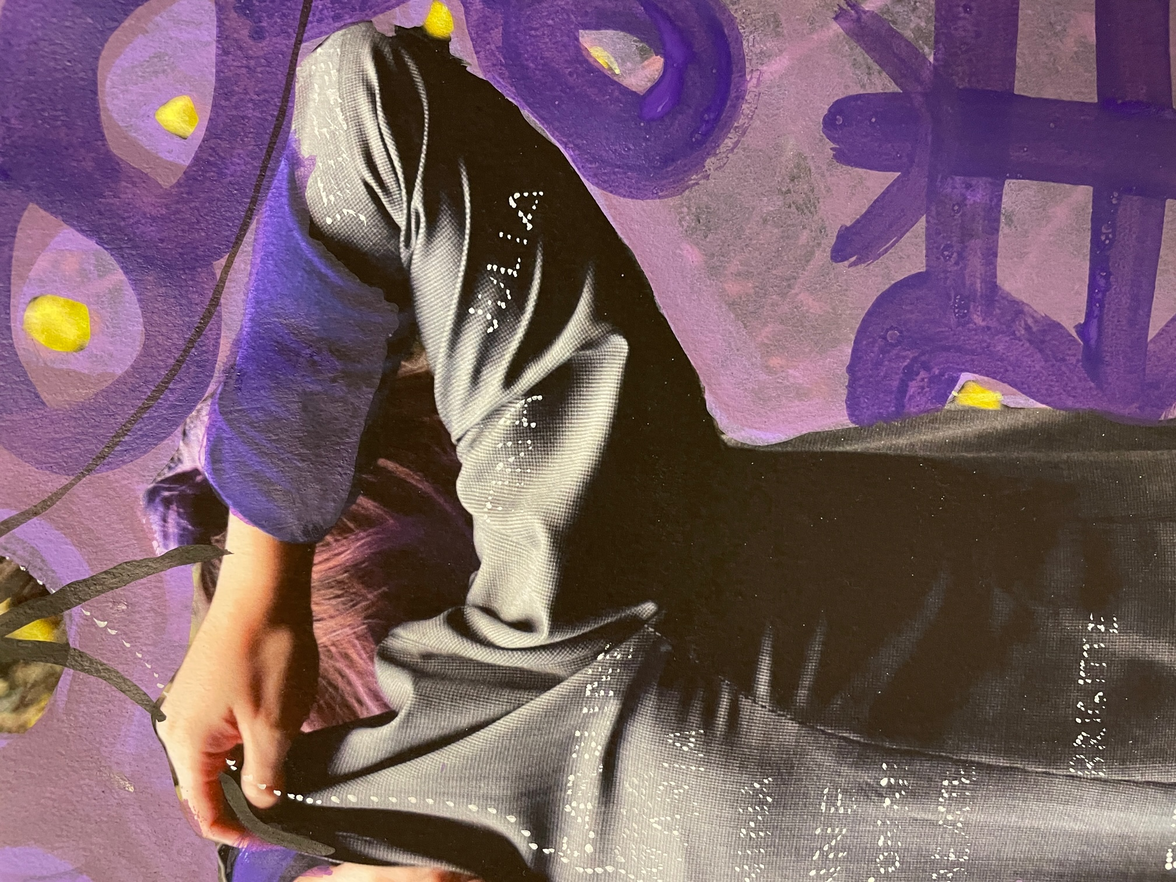Video of experiment N°1
Exploration of a Monument of Patriarchy
Monument: Chapel of Marian Apparition in Bildstein (A)
Movie - Transformation of the patriarchal Chapel of Marian Apparition into Feminist Counter Narratives.
Video: Test for Patriarchal Structures of the Chapel of Marian Apparition in Bildstein (in the future the test is going to be part of the Exploration Experiment)
I used the documentation material (videos, audiofiles, photos) of the transformance for the visual exploration.
I created the first movie to elaborate on the idea of a Monument for Anger. I mixed this up with the documentation of the transformance, which lead to the separation of documentation video and FEMonumental Movie Making in the further research.
I used the results from the Exploration Experiment to create the Test for Patriarchal Structures and to create the first Transformance protocol
overpainting1: can you hear my boining blood?
text written on it (on the white rim around it):
IS THERE A PLACE FOR MY ANGER
CAN YOU FEEL MY TEETH IN YOUR FLESH
DO YOU FEEL THE FLAMES IN MY EYES ON YOUR SKIN
CAN YOU HEAR MY BOILING BLOOD
DO MY SCREAMS RING IN YOUR EARS UNTIL THEY BLEED
BLEED LIKE I AM BLEEDING
DO YOU TRY TO CLIMB THE HIMALAYA OF MY HIDDEN ANGER
ARE YOU AFRAID OF MY ANGER
CAN YOU TELL ME WHERE TO PUT IT
From the photographs of the transformance, I created the first overpaintings. The findings of this process with the chapel influenced the design of my artistic research process and the increase of methods used with the Statue (Monument N°2).
Continue to explore the process with the second Monument.
Reflexion and Conclusions:
It rained a little. It was quiet. I met 4 people, we greeted each other. They didn’t care about what I was doing. I stopped talking to the recorder while they were passing. It was a good decision, to start with a monument near the forest, where there are not many by-passers. I had time and space to engage with the monument and to find out, what I need for my further experiments.
What happened in this experiment?
I felt lost at the beginning. I didn’t know how or where to start. The script/score helped. I walked around the monument and inside, I put my body next to it, measured it with my steps and my height. I filmed it, looked at it closely, smelled it, and listened to it.
I was confused, because I couldn’t feel the patriarchal structures at first. It is a quiet place, a place for prayer where people put their sorrows and fears, where they ask Mother Mary for help. It made me sad. I didn’t know what to do with this monument. I measured it with my steps, and measured a space of the same size next to the chapel in the field, to create my own space, my counter narrative space, my counter monument space. I started to clean that space a little (I moved fallen leaves out of it) and to walk around in it. My view onto the chapel changed. I thought about, what kind of monument I would like to have there and I figured, that this mother figure is quite annoying to me. I would really need some different female “goddess”. The atmosphere in and around this chapel is soaked in motherly and caring attitude. The way I behave and feel here, the reactivated inscription in my body and mind, is the attitude of the obedient woman, who serves her family and community, who takes care of everyone, who prays for everyone. On the Altar in the chapel lies a notebook where visitors write their prayers and wishes and thanks in. Most messages are from women and most messages are prayers for the family and community. I pass by this chapel often and I see mostly women praying in it, women taking care of the flowers, women lightning candles, women visiting with their kids.
Women are mothers, women take care of the family and of the community, women pray, women pray in little chapels to mother mary.
That is the main message I discovered in this experiment from the monument.
From my notes “what the chapel tells me”:
You are safe here, if you are behaving accordingly.
Be well-behaved, good, decent, devotional
Here is a mother to whom you can come and unload your worries and sorrows. The holy mother cares for you.
Mother Mary knows the pains of women.
You need to be a good and caring woman/mother.
You as a woman have to care and pray for the whole family and community.
If I (Mother Mary, God) do something for you, you owe me and have to worship me, build a chapel for me. I keep you safe if you worship me and follow my rules (= Herrschaft und Folgschaft/Knechtschaft, rule/dominance and servitude/vassalage).
Conclusions:
- I found it very helpful, to conduct this experiment without continuing directly into the transformation ritual (as I planned to do in general at the monuments of patriarchy). I discovered, that I need time to process what I experience and detect from the monument. I would not have been able to step directly into the ritual after this. I need time between the first experiment/exploration with the monument and the transformational ritual to process the information from the monument, to connect my on site research with the historic research and to extract the patriarchal structures from that. Then I will be able to decide on the concrete materials (paint, strings, tape, chalk, tools…) I want to use and to design the ritual protocol for the specific monument.
- I need to define my own ritual space NEXT to the monuments, where I will create my feminist counter monument narrative. This space needs to be prepared and cleaned during the preparations for the ritual. Different tools according to weather and the area of the monument may be needed (broom, snow shovel, rake…)
- I felt the urge to paint, draw and create something out of the paintings – to have different surfaces to paint on (paper, textile, canvas, wood…) which I can place differently in my ritual space. I may need string, tape, wooden sticks, stones… to have material to choose from to find different ways to place the drawings and paintings, to build something with them in this space
- Use of the camera: I enjoyed to use the camera directly to discover the monument – I would like to have one camera with a camerawoman filming me and the monument and one camera in my own hands, filming from the “inside view”. (Maybe I don’t need someone taking photographs, I can use video stills?)
- Use of the recorder: same as the camera, I enjoyed to use it as my tool, in my own hands, talking into and with the recorder.
- Inside/outside view: I thought it would be interesting to have something like a giant hoodie on my costume, which I can pull over my head, to cover myself and to talk in this little “bubble” to the recorder and my camera– to play with the intimate and the public during the performance but also in the movie (intimacy and vulnerability as performance methods)
From my notes “what the chapel tells me”:
You are safe here, if you are behaving accordingly.
Be well-behaved, good, decent, devotional
Here is a mother to whom you can come and unload your worries and sorrows. The holy mother cares for you.
Mother Mary knows the pains of women.
You need to be a good and caring woman/mother.
You as a woman have to care and pray for the whole family and community.
If I (Mother Mary, God) do something for you, you owe me and have to worship me, build a chapel for me. I keep you safe if you worship me and follow my rules (= Herrschaft und Folgschaft/Knechtschaft, rule/dominance and servitude/vassalage).
Reflexion / Introspection
Transmedia Performance Art Ritual N°1 – Chapel of Marian Apparition, Bildstein
26th November 2022 – 10-12 am
I am very tired. Before the performance: I feel unprepared, I have everything that I need prepared, but if feels strange that I don’t know what exactly I am going to do on site. I have a ritual protocol, but I didn’t try it out yet! Yes! Because it is an experiment!
It feels strange.
The weather is okay, foggy and dusty, the air is wet, but it doesn’t rain.
We arrive on site, it is somehow dark, because of the clouds, very grey. Grey, like the costume that I choose. We set up the camera. I brought Nina (artist, photographs my performances) and Matthias (boyfriend, has nothing to do with art, would have better things to do, took over from another friend who got sick) with me. I explain them my plan and the ritual protocol and what I want them to do. I start to prepare the ritual space. The ground is very wet and muddy. I clean the space. I feel impatient. I feel impatient because I don’t know what is going to happen. And I feel impatience from Matthias, because he is unprepared and had to rearrange his plans. His phone is the one we use to film the total perspective, and it is not fully loaded. This makes me nervous.
I am having my period, I have cramps and pain in my back and I am tired and I just want to lie on my couch. This makes me impatient. But I am here and want to do the experiment. It is only an experiment.
I brought a lot of material from my studio. I put it into the ritual space and arrange it somehow. That is not easy, because the grass and plants are wet and there are many stinging nettles. The things I put on the ground get muddy.
I follow my ritual protocol. I go to the nearby little stream to wash face, hands and feet. The cold water is nice. It helps me to focus. I feel ready. I am glad, that the weather is grey and wet and nobody else is around.
I put my costume on and smoke myself and the space. I comment on why I chose this dress and what it brings to the ritual. I like it. It feels good to wear it. I paint my fingers purple, to have something that connects all the rituals and to move into the other state of being, that I need to perform the ritual.
I move around the chapel and touch it, lean myself against it. My fingers are full of wet paint, so I cannot use my hands and need to touch the monument with other body parts: face, back, front, legs… I connect, I feel my body, I feel the cold walls, I feel the hard stone, I feel the stability of the monument and the softness of my body.
I recite the “prayer of love” and enter into the ritual space. The poem helps to focus on what I am doing. It helps to start the conversation with the monument.
I am in the ritual space and I do the “test for patriarchal structures”. It is long and takes a while. It is interesting what different answers arise than from the score that I used for the first exploration experiment. But I really need to do the test in the exploration experiments. It is another way of doing/thinking than what I want to do in the rituals. I need to have already a condensed selection of patriarchal structures, of answers to that test for the monument when I start the ritual. It was strange to do that now and it took really long. It was hard to find immediately answers that I could use for the deconstruction. The deconstruction part was good. I need to take longer for that the next time. I rushed a little, I didn’t take all the time I would have needed to get deep into the feeling. It was more acting and doing than feeling it. The-getting-in-deep is what I usually do alone, in my studio. It felt strange to try to do this in public. I need to get into that and get used to that. I felt a little stressed.
The answers that I choose from the test for the deconstruction were: God decides everything. I have to behave and be a good girl. Women are mothers. I read them and repeated them in different connotations and voices and rhythms. There I could take more time. It is an important part and I didn’t do it long enough, the meaning didn’t fall apart yet.
After the deconstruction I started to find new answers, counter narratives. I was stressed, it took already so long until there. I moved a little, started to draw. Moving did not feel very comfortable, because it was very wet and muddy and the ground uneven and steep and full of stitching nettles. I had the feeling of not having enough time to get into it. I felt pressure because of my assistants, because they had to be in this cold wet place and watch me and I had the feeling that there is not much to watch and they could not be interested in this trying to find access… I cared too much about them. And I cared about the battery of the camera. And my period hormones make me feel insecure and make me want to hide and not be seen by anyone.
But anyway, as a counter narrative I found that I wanted movement. I wanted something that moves, is fluid, is growing and changing. I would create a counter monument that moves and grows. I painted the movement, first on a paper, then on a painting canvas cloth. I started to paint with a brush and then changed to paint with my fingers. I got angry. I wanted a counter monument for anger. A place where everyone can be angry, put their anger, celebrate their anger. I moved with the painting, waved it around. I put it on the ground and put some nettles on top of it. They should grow on it. There should grow something big (maybe a tree), where everyone can put colourful paintings of anger on it. Or express their anger however they want. It would be a monument that remembers us of our anger, of our need to express it and to express it in a safe way, that does not hurt others. It would remind us of all the pain we cause each other through not expressing our anger accordingly, of all the power games that result from unsolved anger issues.
That was the answer that I found.
I felt very strange during the ritual. Not free in my movements or in what I am doing. I felt being watched, which I was. But it were two people who I love and who I really trust – so why was it so strange?
I didn’t feel like really “in it”. I was doing and thinking, but not feeling and living it. It felt like working. And I was stressed.
It felt like the first rehearsal for a performance. But this was it – there won’t be another performance on that monument site. This feels frustrating. Unfinished. And yes, it is unfinished, I will continue it, but on different sites. This WAS the first rehearsal, the first try out, the first experiment. I don’t know what I expected. It is just the same as always, after the first try out. I get frustrated and confused about not being at the core of it yet. I am impatient. It is the normal process and it is a good sign, that it is the same process as always. The difference is, that the process takes place in public! I make my process public! This is new for me.
In fact, most things worked: I have videos from a total perspective, I have some videos from my perspective, I have audio recordings, I have a lot of photographs and I found a counter narrative and idea for a counter monument. Plus, I know now much more about how to do it and what I need to change for the next time.
This was a good beginning of the process. Even if it does not feel good.
What to improve for the next ritual:
1. The test for patriarchal structures is part of the exploration. For the ritual, I bring with me already a condensed collection of patriarchal signs and structures, of answers to that test to work with.
2. Take more time! If the test is nothing to worry about during the ritual, I have more time for everything else. I need to calm myself down and remind myself constantly to take more time. It is okay if my assistants sit and watch me sitting and watching and waiting for inspiration.
3. Better preparation of technical equipment. I need to plan better, which cameras I use for what and that their batteries are full. I hate to depend on others, but I have no other options. I cannot do it alone. This stresses me and I have to live with that.
4. Find out which video format is the most convenient one to film. Because I used now 4k 30fps – the quality is great, but the files are so big, that it is complicated to transfer them from the iphone to my Microsoft pc. Also they have a format, that my video editing programme cannot read and I first have to convert them with another programme. It is very complicated and time consuming to prepare the files for the editing. I need to find out how to make that easier before the next experiment.
5. Better preparation of body and mind. I need to have minimum one day before the ritual, where I do not do anything else, but prepare myself for the ritual. This preparation entails time to relax and calm down. I felt stressed because I was writing BOKs the day before and I wanted to finish them as fast as possible. I took this stress with me to the ritual. This means I have to plan my time accordingly.
What worked well:
- Nina as performance photographer – think about and talk to her, what she could get from me as an exchange if she photographs all of the rituals.
- Costume
- Purple colour to have something that connects all of the performances
- The ritual protocol in general, to have something that I can follow.
What did the different artistic means and materials do?
- Costume: it was good to slip into the costume, to put the role of the ritual performer on. It felt good, to be not alone, but to have other women (in a symbolic sense) with me. While I was moving through the ritual space/counter monument space, I played with the cardigan and it felt like “blessing” the space with the fabrics of the costume, with the spirits of these other women.
- Purple paint on my fingers and in my face: I cannot tell why, I just need this colour. It makes me feel like a witch. It helped me to feel and connect with the monument, because I couldn’t touch it with my fingers (wet paint) and had to touch it with the rest of my body. My movements changed through that. I used my whole body because of that.
- Ritual protocol: helped a lot. I could follow it and had something to hold on to. It helped to focus and to get into the process.
- Poem “prayer of love”: helped to focus, to connect me to the research, to the monument and to myself.
- Preparing the ritual space: marking the space is helpful to make the borders visible. It forced me to go into every corner. Preparing and cleaning it made me connect with the place and get familiar with the size.
- Cleaning of artist at the nearby stream: helped to focus and be fully present.
- Smoking with sage: makes me feel like a witch, powerful and mystical. It gives the ritual a smell and makes the air visible through which I will be moving and performing. It is like the marking of the ritual space into the height, into the air.
- Talking into the recorder: talking helps with thinking. It was fun and strange, it felt like exhibiting my feelings and thoughts, making my inner public
- Filming from within:
- Painting: adding colour to thoughts, accessing emotions, having a materiality with which I can move differently, which helps me to think in other dimensions
- Moving around the space: feeling my size in comparison to the space, in comparison to the monument. Being a counter narrative because I am performative and moving and the monument is still.
- Writitng reflexion/introspection: what happens in my female mind and body? What patriarchal structures are triggered by this process? What patriarchal structures can I detect in my artistic practice? What counter narratives arise from my experience of the process? What does my body add to the experiments? Adds insight from within my body and mind. It is a subjective perspective, how I experience. It is a feminist counter narrative in itself. A counter narrative to what I narrate when I want to create a feminist counter narrative. Are they alike? My personal experience and what I want to create?
Ritual Protocol N°1
Transmedia Performance Art Ritual N°1
Chapel of Marian Apparition in Bildstein
Some theoretical background to patriarchy as a form of domination, to help me to detect the forms of domination (patriarchal structures):
Patriarchy is a form of domination (Herrschaft), of domination of male humans over not-male humans (sexism). Other forms of domination are classism and racism. The domination over nature through culture is another form of hierarchy and domination. All forms of domination serve the benefit of the ruling elite and not humanity or earth as a whole. (see Seghezzi 2012, p. 426)
This leads to several aberrations (see Seghezzi 2012, p. 427-430):
1. Separation of the poles into extremes: the poles are separated into mutually exclusive extremes, this is dualism.
2. The extremes are being assessed into good and bad. The extremes are assessed in a good and a bad pole, into good and bad people etc. The power of definition lies with the dominators.
3. Extremes are fixed: into fixed hierarchies, fixed gender roles, property fixed to an owner, god fixed as being male etc.
4. The domination creates “the Evil” by itself: random definition of “the Evil for the benefit of the domination, e.g. the pagans are the evil, the “others” are the evil etc.
„Solange ich ohnmächtig, neidisch oder selbstzerstörerisch denke, fühle und handle stütze ich Herrschaft und führe das fort, unter dem ich leide.“ (Seghezzi 2012: p.434)
(As long as I think, feel and act impotent, jealous or self-destructive, I support domination and continue and support the structures under which I suffer.)
Source:
Seghezzi, U. 2012. Macht Geschichte Sinn - Was uns mitteleuropäische Mythen, Sagen und Bräuche über unsere Zukunft erzählen. Triessen, Van Eck Verlag.
RITUAL PROTOCOL to use on site for transmedia performance art ritual
1. PREPARATION – SETTING THE STAGE
- Set up cameras and the audio recorder. Start recording/filming.
- Mark the ritual space, the space of the counter monument next to the patriarchal monument (wooden sticks, string, natural materials)
- Prepare the materials: put your materials (recorder, camera, painting and drawing materials, ritual protocol, notebook etc.) into the ritual space.
- CLEANING: first: cleaning of the ritual space (remove trash and what you consider as dirt in this place or what you don’t like to have in the space). Second: cleaning of the artist, clean feet, hands and face with water (go to the nearby stream). Third: fumigate artist and ritual space with salvia.
- Prepare Artist: put on costume.
2. ENTRANCE
- Circle, feel and touch the monument of patriarchy.
- Stand outside of the border to the ritual space.
- Close your eyes. Breath three times deeply. Feel your feet, feel your whole body, be fully present. Open your eyes.
- Enter into the ritual space of the counter monument. Walk around the ritual space and make it your own.
- Say the prayer of love, loud with full intention, facing the monument.
My prayer of love
You are a Monument of Patriarchy.
I am a woman of patriarchy.
I am a feminist. I am a symptom of patriarchy.
I am an extreme
And I am the deconstruction.
I am the pen to write a counter narrative.
I play with the fire,
But I don’t want to burn us.
I test the extremes
But I am searching for balance.
I am a self and
I am a structure
I left the ego to return to it later.
I am now open for the collective that we are.
I am here to write with my body and my voice
To write with my art stories of change
To create a chaos of layers of meaning
To deconstruct through extremes
To smash binaries with the deepest understanding of our longing for love.
I AM A LOVER
(not a sinner)
I AM A LOVER
(not a fighter)
I AM A LOVER
(not a ruler)
I AM A LOVER
(not a victim)
I AM A LOVER
I AM A LOVER
I AM A LOVER
3. DECONSTRUCTION
To deconstruct patriarchal structures, you need to detect them first.
Test for patriarchal (and other) dominant structures of monuments (inspired by Seghezzi):
- What dualisms/binaries do you find in the narrations of this monument? Are they exclusive and extreme? Or is it more a fluid scale?
- Is there some “other” made responsible for someone else’s good or bad luck?
- Is there a hierarchy between “good” and “bad”? What attributes does the hierarchy focus on? (gender, race, class, religion, …)
- What behaviour is considered as “good”? What is considered “bad” or “evil”? Who decides what is “good” and what is “evil”? Who benefits from this?
- Do you feel that you should orient yourself here on the opinions and wishes of others? Of whom?
- What hierarchies can you detect here? Where do you see yourself in that hierarchy? Do you put yourself over or under others? Over whom? Under whom?
- Do you feel powerful or powerless? What evokes these feelings?
- Do you feel that you can act flexible and free in this place? What thoughts are limiting you?
- What rules do you follow here? Who’s rules do you follow here? How do you know about those rules?
- Do you feel shame? About what? What makes you feel that way?
- Do you have a guilty conscience? About what? What makes you feel that way?
- Do you feel fear? What are you afraid of? What makes you feel that way?
Answer the questions by talking into the recorder. Answer as direct and honest as possible. You can use all materials to find your answers (drawing, painting, writing, moving, talking, playing with material)
- write those answers, that touch you most (or maybe also the most obvious ones?), onto a piece of paper. Shout them out loud. Repeat them in different ways and connotations, until they “fall apart” in their meaning and intensity. Then destroy the paper.
4. LIMINAL PHASE
You are now in the space in-between. The old destroyed, the new not yet here. This is a space of chaos, dreams, ideas, fears, visions and crisis.
- Create new answers; answers that you would like to give to the test-questions above while facing the new counter monument.
- Play with the genders: exchange the gender of the figures of the monument and its narratives. What changes?
- Move your body and try out different ways to create a counter monument with your body and language. What does your body narrate with what movements and postures? What would you like to narrate? Ask yourself: does this have connotations of domination? How can I create something beyond dominant structures? If you are unsure, repeat the test for domination for whatever new narrations you found.
- If needed, use painting, writing and installation materials to find new feminist counter narrations. Think and talk through the artistic means. Question yourself, question everything. This is the liminal stage.
5. TRANSITION INTO THE NEW - EXIT
Find minimum one sentence/picture/movement/idea, which you consider as feminist counter narrative to the patriarchal monument from your experiments in the liminal stage. Repeat it three times (talking, moving, drawing, whatever form it has). It is okay if it varies, it is not being fixed. (put it in any form onto your costume?)
- Feel if there is something else you want to do. And do it.
- Decide if you want to leave something in this space or if you take everything with you.
- Then stand at the border of the ritual space (inside). Close your eyes. Breath deep three times. Feel your body. Be fully present.
- Recite the prayer of love, loud and full with intention.
- Step out of the ritual space. Take your costume off. End.
- take your materials with you. Leave there, what you decided to leave there.
Chapel of Marian Apparition / Erscheinungskapelle
location: Dorf 77, 6858 Bildstein, Austria
History of the monument:
The chapel of Marian Apparition in Bildstein was built in 1887 to remember of the Marian Apparition in 1629. A bright female figure in white clothes appeared to two brothers who identified her as Mother Mary. The apparition told the boys to remind their father of what he had promised to her. The father had prayed to the holy mother to prevent his household from the plague/black death and promised to build a chapel from stone for her, if she protected his family. After the apparition, the father started to build the chapel, on the spot where now the basilica of Bildstein stands. The first chapel and later the church were a popular pilgrim place, which led to many chapels and side way shrines in the whole area of the village (which stretches over three hills). One of them is the chapel of Marian Apparition, 250 meters from the basilica.
source:
https://maria-bildstein.at/basilika/geschichte-kunst/marienerscheinung/
https://maria-bildstein.at/basilika/rund-um-die-basilika/erscheinungskapelle/
